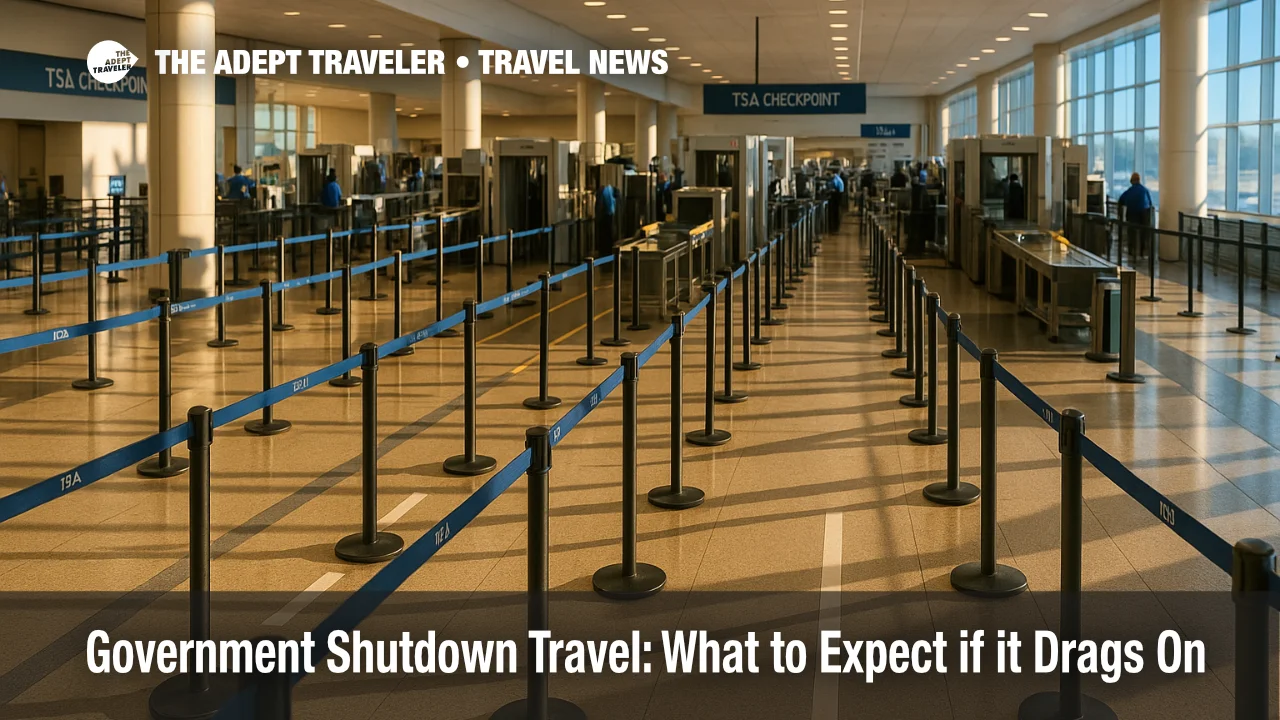Government shutdown travel: What to expect if it drags on

A prolonged government shutdown can ripple through the travel system even while flights keep operating. In the 35-day shutdown from December 22, 2018, to January 25, 2019, essential personnel such as Transportation Security Administration officers, Customs and Border Protection officers, and air traffic controllers worked without pay, and operations strained as the weeks wore on. Historical patterns, combined with current contingency plans, point to longer airport lines, sporadic checkpoint consolidations, and occasional flow restrictions in busy airspace if the current lapse extends.
Key points
- Why it matters: Staffing stress builds after two to three weeks, increasing delays and checkpoint disruptions.
- Travel impact: TSA absenteeism spiked near day 30 in 2019; ATC shortages triggered a LaGuardia ground stop.
- What's next: If this shutdown persists, expect selective checkpoint closures, trusted-traveler slowdowns, and targeted ATC traffic management.
- Back pay is guaranteed by law once funding resumes, but cash-flow strain still drives absences.
- Visa, passport, and CBP inspections continue, though non-urgent services may slow.
Snapshot
During the last prolonged shutdown, the federal workforce operated under emergency rules. TSA reported rising unscheduled absences approaching 10 percent around day 30, prompting airports like Miami International to temporarily close or consolidate checkpoints to keep screening effective. On January 25, 2019, the Federal Aviation Administration implemented traffic management actions that briefly halted arrivals to New York's LaGuardia Airport due to controller staffing at key facilities, causing knock-on delays at Newark and Philadelphia. CBP inspection at ports of entry continued as an excepted function, while ancillary traveler programs and enrollments slowed. Today's agency playbooks again classify airport security, customs processing, and air traffic control as excepted, meaning they continue without pay. If the lapse lingers, travelers should budget extra time and monitor airport advisories.
Background
The 2018-2019 lapse lasted 35 days, the longest on record. Under updated Office of Personnel Management guidance and the Government Employee Fair Treatment Act of 2019, excepted employees must work and are guaranteed back pay when appropriations return. That legal backstop did not prevent operational friction in 2019. TSA's absentee rates climbed as missed paychecks accumulated, driving hour-plus lines at peak hubs and tactical checkpoint closures. Air traffic control facilities, already lean, managed safety by slowing flows when staffing ran tight, culminating in the LaGuardia ground stop on January 25. GAO and post-mortems noted lingering effects after reopening, including deferred inspections and training backlogs. Current Department of Transportation and Department of Homeland Security shutdown plans keep core travel services running, but noncritical functions, enrollments, and some certification work may pause if funding lapses persist.
Latest developments
Government shutdown travel impacts: TSA lines, ATC delays, and CBP operations
If this shutdown extends beyond two weeks, expect a familiar pattern. First, TSA will prioritize security effectiveness by consolidating lanes or entire checkpoints at off-peak terminals, which can mean longer walks and longer lines during rush periods. Second, air traffic facilities may use ground delay programs or arrival metering to safely match traffic to available staffing; the busiest choke points are in the Northeast corridor and Florida flows, where a single facility's constraints can ripple widely. Third, CBP inspection at airports and land borders continues, but Trusted Traveler Program enrollments and some low-priority adjudications can slow or pause, creating appointment backlogs. Meanwhile, training pipelines and some FAA certification or oversight tasks can face delays, which do not immediately affect today's flight but can compound if the lapse endures. For practical planning, arrive early, use PreCheck if eligible, keep carry-ons tidy to speed screening, and monitor airport and airline alerts for checkpoint or gate changes.
Analysis
Operational risk in a shutdown is cumulative, not instantaneous. In week one, most travelers notice little beyond tense headlines, because excepted personnel still show up and managers flex schedules. In weeks two to four, cash-flow strain on unpaid workers historically drives absentee spikes at TSA and fatigue inside ATC facilities. Managers preserve safety by reducing throughput, not by cutting corners; to a traveler, that looks like longer queues, pop-up lane closures, or arrival delays and reroutes concentrated around the Northeast and Florida. CBP's front-line inspections remain open, but enrollment centers for Global Entry and similar programs are often curtailed, increasing waitlists. The legal guarantee of back pay removes the fear of permanent lost wages, yet it does not pay this week's rent or child care; that is why the day-30 mark in 2019 coincided with the sharpest operational strain. Today's DOT plan notably allows ATC hiring and field training to continue, which should blunt longer-term staffing damage compared to 2019. Still, if the lapse stretches toward a month, expect a recurrence of tactical checkpoint consolidations and occasional ATC flow actions at major hubs.
Final thoughts
Travel remains safe during a government shutdown, but friction grows the longer it lasts. If this lapse goes beyond two to three weeks, build in extra time at security, watch for checkpoint consolidations, and expect targeted ATC delay programs at peak hubs. CBP will keep borders open, though trusted-traveler processing may lag. Keep plans flexible, monitor your airport's advisories, and remember that the system's stress is temporary. With preparation, you can navigate a prolonged government shutdown travel period with fewer surprises.
Sources
- Guidance for shutdown furloughs, OPM
- Government Employee Fair Treatment Act of 2019, OPM memo
- DOT contingency plan for a lapse in appropriations (ATC excepted, hiring/training noted), U.S. DOT
- 2018-2019 shutdown length and aviation impacts overview, GAO-20-377
- TSA unscheduled absences reached 10 percent near day 30, CBS News
- LaGuardia ground stop and FAA statement citing staffing issues, CBS News
- Agency roles during a shutdown; DHS procedures for a lapse in appropriations, DHS
- AP explainer: Travel impacts in a prolonged shutdown, AP News
